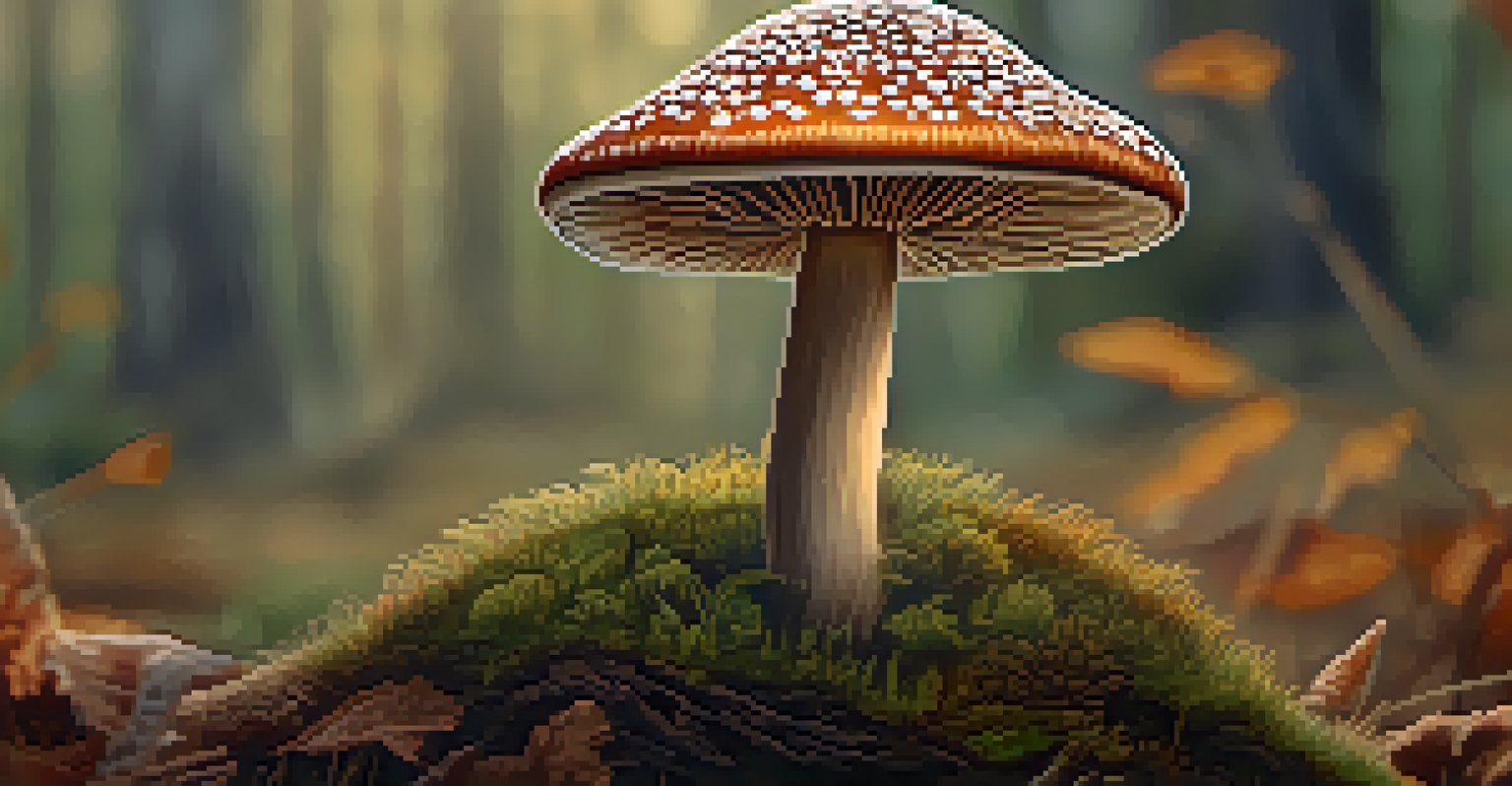Transformative Healing: Entheogens in Holistic Care

Understanding Entheogens and Their Role in Healing
Entheogens are substances that have been used for centuries in various cultures to facilitate spiritual experiences and promote healing. Examples include psilocybin mushrooms and ayahuasca, which have gained attention for their potential in therapeutic settings. These substances interact with the brain's serotonin receptors, often leading to altered states of consciousness that can foster introspection and emotional release.
When you change the way you look at things, the things you look at change.
In holistic care, entheogens are viewed not just as drugs, but as tools for deeper self-exploration and connection with the inner self. This perspective encourages individuals to address underlying emotional and psychological issues, offering a path to healing that traditional medicine may not fully address. By facilitating profound experiences, entheogens can help individuals gain new insights into their lives.
As more research emerges, the conversation around entheogens is shifting from taboo to legitimate therapeutic options. This change is paving the way for a broader acceptance of these substances in holistic practices, highlighting their potential to enhance well-being and personal growth.
Historical Context of Entheogens in Healing Practices
Throughout history, various cultures have utilized entheogens as sacred plants in ceremonies aimed at healing and spiritual communion. Indigenous tribes in the Amazon, for instance, have used ayahuasca for generations, believing it connects them to the spiritual world and offers guidance. Similarly, ancient Greek cultures engaged in the Eleusinian Mysteries, which involved the use of psychedelics in rituals to promote healing and enlightenment.

These traditional practices highlight the significance of community and ritual in the healing process. Participants often engage in guided experiences that provide a safe space for exploration and emotional release. This communal aspect underscores the idea that healing is often enhanced when shared with others who provide support and understanding.
Entheogens as Healing Tools
Entheogens like psilocybin and ayahuasca are being recognized for their potential to facilitate emotional healing and self-exploration.
As modern society begins to rediscover these ancient practices, there’s a growing interest in how entheogens can be integrated into contemporary therapeutic settings. By understanding the historical context, practitioners can better appreciate the potential benefits and challenges of incorporating these substances into holistic care.
The Science Behind Entheogens and Mental Health
Recent scientific studies have started to shed light on the therapeutic potential of entheogens in treating mental health conditions such as depression and PTSD. Research has shown that substances like psilocybin can lead to significant reductions in symptoms, often after just a few sessions. This has sparked interest in their use as adjuncts to psychotherapy, offering a new avenue for individuals who may not respond well to conventional treatments.
The mind is everything. What you think you become.
The mechanism behind this effectiveness lies in the brain's neuroplasticity, which is the ability of the brain to reorganize itself by forming new neural connections. Entheogens may help facilitate this process, allowing individuals to break free from entrenched patterns of thought and behavior. This can result in a fresh perspective on personal challenges, paving the way for lasting change.
However, while the promise is immense, it's essential to approach this field with caution. More extensive studies and careful monitoring are needed to establish safety protocols and understand the long-term effects of entheogen use in therapeutic settings.
Entheogens and Emotional Healing: A Personal Journey
Many individuals seeking emotional healing report transformative experiences with entheogens, often describing a sense of connection to something greater than themselves. For example, a person struggling with grief might find solace in a guided session with psilocybin, allowing them to confront their loss in a profound way. These experiences can lead to significant emotional breakthroughs, helping individuals process complex feelings.
The journey often involves navigating difficult emotions, which can be daunting but ultimately rewarding. Participants frequently describe a sense of catharsis, as they confront and release pent-up feelings that may have been buried for years. This process can foster a deeper understanding of oneself and promote a sense of peace that lingers long after the experience.
Historical Use in Healing
Various cultures have historically utilized entheogens in rituals, highlighting the communal aspect of healing and spiritual connection.
It's important to note that these journeys should be approached with intention and care. Working with trained facilitators can help ensure a safe environment, allowing individuals to explore their emotions while receiving the support they need.
Integrating Entheogens into Holistic Care Models
Integrating entheogens into holistic care models involves a thoughtful approach that respects both the potential benefits and the need for safety. This can take the form of therapy sessions that incorporate guided experiences with entheogens, complemented by traditional therapeutic techniques. Such integration aims to create a comprehensive healing environment that addresses the mind, body, and spirit.
Practitioners are encouraged to create individualized treatment plans that consider each person’s unique history and needs. This personalized approach can enhance the effectiveness of entheogens, ensuring that they serve as a supportive tool rather than a standalone solution. Collaboration among healthcare providers, therapists, and trained facilitators is essential in designing these holistic care models.
As more practitioners explore this integration, sharing insights and experiences will be crucial. Building a community around these practices can help foster a culture of safety, respect, and understanding, ultimately benefiting those seeking healing.
Challenges and Considerations in Using Entheogens
While the potential for entheogens in healing is exciting, there are several challenges and considerations to keep in mind. Legal restrictions in many regions can hinder access to these substances, creating barriers for those seeking alternative therapies. Additionally, the stigma surrounding psychedelics can deter individuals from exploring these options, despite their therapeutic potential.
Safety is also a paramount concern. Not everyone is a suitable candidate for entheogen-assisted therapy, particularly those with certain mental health conditions or a history of substance abuse. Therefore, thorough screening and assessment by qualified professionals are essential to ensure a safe and supportive healing environment.
Future of Entheogens in Therapy
The growing acceptance of entheogens in therapeutic practices suggests a promising future for holistic health, blending ancient traditions with modern science.
Lastly, continued research is vital to fully understand the effectiveness and safety of entheogens in holistic care. As the field evolves, ongoing dialogue among researchers, practitioners, and patients will be essential in shaping best practices and guidelines.
The Future of Entheogens in Holistic Health Practices
Looking ahead, the future of entheogens in holistic health practices appears promising, with increasing acceptance and interest from both the public and the medical community. As more studies validate their therapeutic benefits, we can expect a shift in how these substances are perceived and utilized in healing practices. This could lead to a broader range of treatment options for individuals seeking holistic care.
Emerging training programs and certifications for practitioners who wish to incorporate entheogens into their practices are already beginning to surface. This movement aims to ensure that those guiding others through these experiences are well-versed in both the therapeutic and safety aspects of entheogen use. The establishment of ethical standards will be crucial as these practices gain traction.

Ultimately, the integration of entheogens into holistic health practices could revolutionize how we approach mental health and emotional well-being. By embracing these substances responsibly and ethically, we may pave the way for a new era of healing that combines ancient wisdom with modern science.